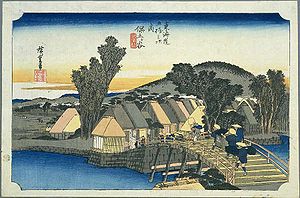- Hodogaya-juku
-
 Hodogaya-juku dans les années 1830,sur une estampe de Hiroshige dans l'édition Hoeido des Cinquante-trois Stations du Tōkaidō (1831-1834).
Hodogaya-juku dans les années 1830,sur une estampe de Hiroshige dans l'édition Hoeido des Cinquante-trois Stations du Tōkaidō (1831-1834).
Hodogaya-juku (程ヶ谷宿, Hodogaya-juku?) était la quatrième des cinquante-trois stations du Tōkaidō. Elle est située à Hodogaya-ku dans la ville moderne de Yokohama, préfecture de Kanagawa au Japon. Son nom s'écrit parfois 保土ヶ谷宿.
Sommaire
Histoire
Hodogaya-juku fut établie en 1601 et c'était la station la plus à l'ouest de la province de Musashi durant la période Edo. Il existe une statue en pierre de Bouddha que les voyageurs pouvaient implorer pour assurer leur sécurité pendant leur parcours du Tōkaidō[1].
L'estampe classique ukiyoe d'Ando Hiroshige (édition Hoeido) de 1831-1834 représente un pont sur un ruisseau, avec deux serviteurs portant un kago fermé vers un village sur l'autre rive. Auprès du pont se trouve un restaurant soba avec des serveuses invitant les voyageurs à entrer.
Stations voisines
- Tōkaidō
- Kanagawa-juku - Hodogaya-juku - Totsuka-juku
Des routes mineures, dont la Kanazawa-Kamakura-dō (金沢鎌倉道), la Hachiōji-dō (八王子道) et la Ōyama-dō (大山道), se séparaient du Tōkaidō à Hodogaya-juku.
Sources
- Carey, Patrick. Rediscovering the Old Tokaido:In the Footsteps of Hiroshige. Global Books UK (2000). ISBN 1901903109
- Chiba, Reiko. Hiroshige's Tokaido in Prints and Poetry. Tuttle. (1982) ISBN 0804802467
- Taganau, Jilly. The Tokaido Road: Travelling and Representation in Edo and Meiji Japan. RoutledgeCurzon (2004). ISBN 0415310911
Notes et références
- (ja)The stone Buddha and Pagoda. Yokohama City Hall.
- (en) Cet article est partiellement ou en totalité issu de l’article de Wikipédia en anglais intitulé « Hodogaya-juku » (voir la liste des auteurs).
Wikimedia Foundation. 2010.
